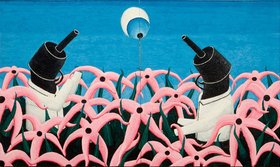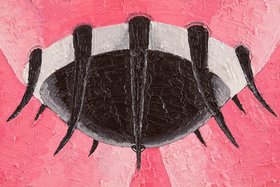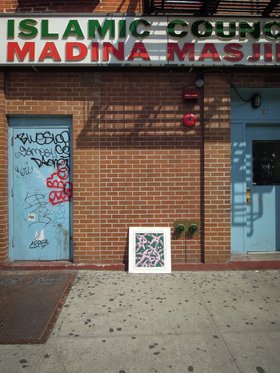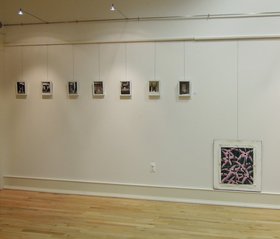Interviews
The Activity of Painting and Other Actions
Nadia Ayari in conversation with Haig Aivazian
Nadia Ayari's work is full of tension. Densely composed with very little breathing room, her thick goopy paintings depict strange and natural settings, where the vegetation and the architecture seem to have been permanently morphed by an undisclosed incident. Branches smothering olives, plump figs gushing fountains of red fluid, intertwined lingual leaves and so on, Ayari's imagery oscillates between gauche sexual insinuations and understated, restrained allegories. All the while the work constructs an eerily surreal landscape devoid of any clear allusion to humanity, but where elements constantly take on characteristics that are not their own. Tension is not only present in the careful and tedious application of the paint, rather it is embedded within every artistic decision Ayari makes: between overtness and subtlety in the politics of the work; between being locked away in the studio and physically engaging with the public realm; between 'bad painting' and geometric elegance – and between painting and other forms of practice altogether. In this interview, Ayari talks about some of these tensions, as well as how her roles as fresco artist, painter, teacher, anonymous curator and pop up art space collaborator, frame her practice.
Haig Aivazian: You are predominantly a painter, but you are also involved in a range of other activities. Can you talk a little about the spectrum of what you consider to be your practice, and how closely related the different aspects are for you?
Nadia Ayari: I define myself as a painter to communicate the physicality of my paintings. I also find the term useful as a conceptual frame for the projects I undertake; what I consider to be my parallel practices. When I first found oil paint, I was enamoured with the American Ab-Exers. I made a lot of mediocre undergrad abstract palette-knife paintings because that's what I thought Painting (with a capital P) was. I was right, only that was Painting sixty years ago. Soon after that initial creative output, I started to question my social responsibilities as an artist and struggled for a long time with the limitations of contemporary Painting in activating meaningful political discourse. For some time, Phillip Guston's canvases provided a model for my paintings' political potential. But after years of working through it, I experienced a turning point in my work, which coincided with my move to New York in 2007. While facing the bourgeois mechanisms on which my paintings relied: galleries, museums and collectors' homes – I decided to establish the conceptual context for the works within my practice. I started documenting vernacular street painting and curating a lecture series. Things grew from there. Currently, my parallel practices include an urban painting project and co-founding an art space. To me, Painting is not only the act of applying oil on canvas, but it is a site for critical and political projects.
HA: You have, for a while now, been invested in fresco painting: it shows up in your projects and you also have been teaching it. How long have you been painting fresco? What drew you to it initially and is interesting about it for you?
NA: You know, I try to avoid using the word fresco when discribing my own projects? It invokes an aesthetic that is so completely stuck in time despite contemporary artists' successful work with the medium. Francesco Clemente made some strong frescos in the 80's and Daniel Bozhkov integrates fresco into his larger relational projects. What I referred to earlier as 'my urban painting project' is more specifically an urban fresco project. In any case, I was introduced to fresco in 2006 at Skowhegan, a summer residency in Maine. I was actually quite resistant to learning the medium (which is the case with most painters, I later found out). Thankfully, enough artists I trusted recommended it and I gave in. It was an eye opening experience that enriched my understanding of painting's historical aesthetics and traditional production. The medium itself is quite amazing, a mix between indirect and direct painting using water based pigment solutions applied on a hardening lime surface. It was a real rush working against the drying plaster and discovering the golden hour. As circumstances would have it, I was learning all this during that summer's Lebanese-Israeli war, making it very hard for me to be still in the residency's idyllic setting. The fresco's labour intensive and time consuming processes kept me focused and productive during that period. I know that is one of the reasons I was became so invested so quickly.
In my recent projects, I use fresco as a gesture: a symbol of itself. I employ a process that allows me to make transportable frescos that I move around. This, given the brittle quality of the sand and lime of which they are made, causes them to crack. The fresco's figurative removal from the wall and its subsequent self-destruction is for me a sort of allegory for the deconstruction of the monolithic art canons to which we are all beholden. The economy of that gesture and effectiveness of its significance compel me to use the medium these days.
HA: In the studio, you tend to work slowly, honing in on a set imagery or a given character over a relatively long period of time and across several iterations. Why do you work in the manner that you do, and what are you trying to get the paintings to do? What do you think is happening to the characters in having them reappearing and repeated in this way?
NA: My paintings are definitely time-consuming in their making and my process tends to get slower as the parameters of my engagement with the narrative I am telling get more complex. I do wish it were the opposite, I would love to produce faster. I work sequentially and exclusively on one piece at a time, whether it is small or large. In each piece, I use a set of characters to tell a portion of a larger narrative. Currently, I am working with three main protagonists: fig, tree, and blood, to relate a story about dominance and desire. For a while, I used to think of each painting as a chapter in a novel. Now that the work is more abstract, I think of each piece as a poem.
Working meticulously with thick oil paint, I focus on rendering the content of the painting clearly and sculpturally. Through this careful impasto, the paintings seduce you into their surreal compositions, slowly revealing the strict and often ruthless politics of their world. A leaf punctures a fig to give it a tongue, a fountain of blood spurts from a splitting fruit to release its painful climax; these are a few of the scenes from recent paintings that achieve this slow, tense read. Maybe, the slower the making, the slower the read? There is no doubt a correlation.
As to your question about the reappearing characters, I think their slight transformation from one canvas to the next reinforces their existence in the world I am presenting, while providing the viewer with disparate aspects of the story. Though, I must say, this is the mysterious part to me. I am not quite sure how working with this same flora for two years now, I am still finding new and exciting images.
HA: Would you say you are a landscape painter? If so, what would the characteristics of that landscape be?
NA: No, I would not refer to myself as a landscape painter. Though, I see why you would ask that. 'Landscape painter' is much too un-sexy a term.
HA: You use the word 'sexy' facetiously, but I like to take things at face value, particularly because I think it is a useful way to maybe think about the place of sexuality in your work and in its politics. You use deliberately sexual terms such as penetration and climax, and the imagery itself often functions like a series of innuendos of varying degrees of subtlety. Also, you just used the term flora, I mean these are most often landscapes of some sort or at least strange nature vivantes, though they do not feel like idyllic far away places. Somehow they feel in proximity to urbania, since they are often figs, olives and other domesticated vegetation but that seem to be returning to their wild selves. Something about sex, politics, landscape, urbania… Thoughts?
NA: Urbania, I like that word. The work definitely explores an urban surrealism that has a sexual and political valence. As a young adult I endorsed 'the Personal is Political' which probably had a lot to do with my Tunisian upbringing. In recent years however, I have been attempting to paint the personal as political. I find it a more productive space and less reactionary framework for the studio.
And I think I'm doing something right. This I realized when I was back home in December. Usually my visits to Tunisia are accompanied by frantic documentation of literal and figurative material for my work: pictures of vernacular architecture, critiques of political campaigns, vignettes of cultural interactions, et cetera. This time was different. Despite the immense political instability, I did not feel the pressure to remember every anecdote because I knew my work was communicating a tension analogous to the social and political one my friends and family are living through. And I mean that in the most humble way possible as this has allowed me to focus on what I can do, rather than worry about what my work could do.
HA: Ok, but this sort of distance, reticence, or indirectness is precisely what the landscape is, isn't it? So, rather than being in the middle of the action, you are in this distanced and highly affected place, which somehow reflects on the politics without representing it. I am not sure I am expressing this the right way, but a few days ago I attended a lecture by Eyal Weizman, who was talking about various forms of truth and testimony invested in non-human things within legal contexts (material evidence). One of the slides that he showed made me think of you: these before and after satellite shots of Darfur from 2003 and 2007 comparing the vegetation density in this particular area. The caption of the slide said something like 'increased vigour of vegetation in areas undergoing ethnic cleansing.' The images communicated this idea that nature in its very state reflects and more importantly can convincingly represent politics, massacres, death and all sorts of other social ills without the need to represent bodies, figures or other forms of direct representation. I think your work functions in a very similar way.
NA: I think placing the work peripherally to existing modes of overtly political cultural productions allows it to sit somewhere between representation and abstraction. The paintings represent political structures but abstract political topics. This framework enables me to avoid sentimentalising causes in which I believe and/or events by which I am deeply affected. But I still worry about political intention not being enough and whether the work is operating within its political intent. But I think that is always an issue for artists.
HA: Do you mean that it is difficult to come up with potent modes when it comes to politics in art? Maybe another way to think about how you position yourself vis-à-vis the political and public realms in your work is to talk a little more about what you were referring to as your urban fresco project earlier. That provides a nice awkward intersection of proximity/distance, visibility/privacy, concrete/flora and also sentimentality and criticality.
NA: That project is the intersection of painting and a relational practice. For the most recent of its installments titled Without Walls, I photographed a 24x24 inch fresco on burlap in front of seven masjids in Manhattan and displayed a photo of each alongside the transportable painting. Leaving the studio and stepping into a public space to produce the project was more distressing than I had realised. I first approached the site selection in a systematic way, focusing on the points they would create on a map. But it quickly became clear, given how difficult it is to find published addresses for these devotional spaces in New York, that I would have to shift those parametres and concentrate on finding masjids in my immediate surroundings. I used my Lower East Side studio as a departure point. This gave the project an abstract biographic narrative that transferred the political substance of the piece from the sites themselves to my interaction with them. And when all the 7x5 inch photos and fresco were installed, the painting, cracked from its travels, took on a symbolic dimension, I began to relate to it as a representation of the devout attendee. This performative transfer of meanings onto the painting made leaving the familiar confines of the studio worth the discomfort the photo shoots brought on. Because of the gendered, highly politicised (and often demonised in this country) nature of these spaces, I did my best to not intrude on each masjids community, which is nearly impossible when holding a camera. But again, once the piece was installed and the painting became the primary character of the narrative as well as the project's only other spectator aside from myself, all the discomfort and questioning was worth it.
HA: It's interesting that the 'art' here is not in the 'Artwork' per se, but rather how the artwork and its baggage and its meaning shift and accrue with the circulation of the work. The work is imbued with meaning along its path. I also remember you speaking about one of your paintings being stuck in Egypt after the revolution broke out and you feeling that this was somehow the epitome of the work. Can you talk a little more about this idea of the shift of meaning after the work is completed?
NA: I think this idea of the work shifting meanings through contexts is a combination of my conceptual and emotional relationship to my practice. In the story you mention, I was expressing my desire for Wild Flowers, one of the paintings exhibited at the 2010 Cairo Biennale to be destroyed: the work depicts two political figures playing catch with an eyeball. This uncharacteristic urge clued me into the extent of the tension between the work and its showing context. I felt strongly that the work's ordeal of having been stuck at the Biennale's US department funded American pavilion during the Egyptian revolution had to activate that strange frame through which it was exhibited by means that it could not possibly achieve via its imagery alone. Immolation was my first thought. Of course that did not happen since the piece was safely returned to my studio in April 2011. To me though, like the frescos I make, that painting looks very different than when it was freshly completed.
HA: Is this eagerness/timidness to engage with the public realm partly a restlessness with painting? Is it about the limitations of the studio?
NA: I think it is about acknowledging the limitations of painting and the contexts available to it. It is not that I am restless with the activity of painting itself. I would be quite happy producing paintings exclusively but that seems to create a vacuum in the work, closing its content off to political and social interpretations that are its main themes.
HA: It is funny to hear you say that. You say you are happy to spend more time in the studio, yet increasingly you have structured your activities in a manner that force you out of it: the fresco project is one example. Can you maybe talk about the curatorial aspect of your practice, mainly can you talk about the space which you helped launch in New York City's Lower East Side?
NA: Sure. A couple of artist colleagues and I stumbled upon a restrictive space that fits our shared conceptual curiosities. Right now, we are running it as an anonymous art project which is why I cannot state its name and place here. And in essence, you are right about me making choices that take me out of the studio rather than keep me in it, this has been the major focus of my practice for the past six months. With it, we are trying to create some friction within the highly refined mercantile system of New York. So far, we are only one project in and we have been able to give the piece we are presenting the merit it deserves, which is really all we are looking to do.
HA: Going back to what you call 'the activity of painting', despite you expanding the meaning of the activity for yourself, in many ways you have had an ongoing and very traditional investment in the medium. I won't ask you why you do it, as you may not have an answer, but could you talk about the evolution of the relationship between the sources of your imagery over time and its directness to the subjects you are seeking to address? In other words, how have you fine-tuned your painting language and application and what do you think that has done to your 'voice'?
NA: I am actually interested in the 'why do it' portion of the question but at the risk of sounding flippant, I will just say that I really love the way paint feels: the colored mud that it is. Over the years, I have pushed the imagery of my paintings from its figurative and representational beginnings into a more abstract language to address a broader scope of subjects within a single painting. In a previous body of work, I used a very different set of characters to relate the story. Some of those characters included a gun-head politician and an eyeball soldier. I was happy with those paintings but felt that trying to represent complex political realities through figuration and a given set of clear signifiers was limiting. I decided then to camouflage the narrative, to abstract it and started repeating pink and black eyeballs until they took up the entire picture plane. The obliteration of the horizon line was an important step into the body of work I am making now, with its dark and shallow space. The development of the work's current fable-like aesthetic, with its repeating characters and rigid compositions, has been accompanied by a fine-tuning of my paint application, which I believe is the clearest indicator of what you call my 'voice'. I slowly paint each image while taking great care in developing the painting's surface. Moving from lean paint to fat and large marks to small, I render each form with its own specificity: I paint figs with horizontal brushstrokes, I apply red flatly and in the direction of the bleed and I build up the leaves with thick calligraphic lines. This combination of textures gives the paintings a sculptural patina in which my hand, the narrator's hand, is everywhere and therefore unseen. For now, I am quite happy with this process and feel I can sit with it for a few years. It seems to be a good way of presenting the content of the work while creating a convincing aesthetic argument.
Nadia Ayari moved from Tunisia to the United States in 2000 where she earned her MFA in Painting at the Rhode Island School of Design. In 2010, she co-represented the US at the 12th International Cairo Biennale and in 2011 participated in the 3rd Thessaloniki Biennale representing Tunisia. Her third solo show, This Place opened at Monya Rowe Gallery, NY in February 2011. Her project with The Third Line, Dubai will be on view in September 2013. She lives and works in New York.









